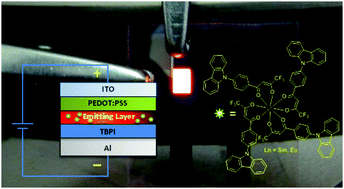Bright orange and red light-emitting diodes of new visible light excitable tetrakis-Ln-β-diketonate (Ln = Sm3+, Eu3+) complexes†
Abstract
The syntheses and luminescent properties of two new visible light excitable lanthanide complexes (NBu4[LnL4]) [L = 1-(4-(9H-carbazol-9-yl)phenyl)-4,4,4-trifluorobutane-1,3-dione; (Ln = Sm3+, Eu3+)] are described. The (NBu4[LnL4]) complexes exhibit bright photoluminescence at room temperature in solid state with characteristic red and orange emissions of Eu3+ and Sm3+ ions, respectively. Photoluminescent overall quantum yield (ϕov) and lifetime (τobs) values obtained for the complexes are 80 ± 8%, 780 ± 6 μs for (NBu4[EuL4]) and 10% ± 1%, 97 ± 2 μs for (NBu4[SmL4]) (λex = 410 nm) in solid state. RM1 calculations were employed for predicting the ground-state geometry of NBu4[EuL4], which shows that the central Eu3+ is 8-fold coordinated. Theoretical Judd–Ofelt and photoluminescence parameters predicted for NBu4[EuL4] from this model are in close agreement with the experimental values, proving the efficiency of this theoretical approach implemented in the LUMPAC software (http://lumpac.pro.br/theory). LEDs with the general structure ITO/PEDOT:PSS (50 nm)/(NBu4[LnL4]) (5%):CBP (66.5%)–OXD7 (28.5%) (50 nm)/BCP (50 nm)/LiF (1.5 nm)/Al (120 nm), using the two complexes as emitters were fabricated via a simple spin coating technique. The device based on (NBu4[EuL4]) exhibits the maximum brightness of 1234 cd m−2, current efficiency of 3.5 cd A−1, power efficiency of 1.3 lm W−1 and external quantum efficiency of 2.3% with a pure red emission. Whereas, its Sm3+ analogue shows bright orange emission with a maximum brightness of 831 cd m−2, current efficiency of 1.4 cd A−1, power efficiency of 0.5 lm W−1, and external quantum efficiency of 1.1%.



 Please wait while we load your content...
Please wait while we load your content...